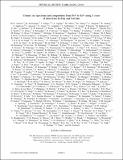Cosmic ray spectrum and composition from PeV to EeV using 3 years of data from IceTop and IceCube
Author(s)
IceCube Collaboration; Arguelles Delgado, Carlos A; Axani, Spencer Nicholas; Collin, G. H.; Conrad, Janet Marie; Diaz, Alejandro; Moulai, Marjon H.; ... Show more Show less
DownloadPublished version (3.294Mb)
Publisher Policy
Publisher Policy
Article is made available in accordance with the publisher's policy and may be subject to US copyright law. Please refer to the publisher's site for terms of use.
Terms of use
Metadata
Show full item recordAbstract
© 2019 American Physical Society. We report on measurements of the all-particle cosmic ray energy spectrum and composition in the PeV to EeV energy range using 3 years of data from the IceCube Neutrino Observatory. The IceTop detector measures cosmic ray induced air showers on the surface of the ice, from which the energy spectrum of cosmic rays is determined by making additional assumptions about the mass composition. A separate measurement is performed when IceTop data are analyzed in coincidence with the high-energy muon energy loss information from the deep in-ice IceCube detector. In this measurement, both the spectrum and the mass composition of the primary cosmic rays are simultaneously reconstructed using a neural network trained on observables from both detectors. The performance and relative advantages of these two distinct analyses are discussed, including the systematic uncertainties and the dependence on the hadronic interaction models, and both all-particle spectra as well as individual spectra for elemental groups are presented.
Date issued
2019Department
Massachusetts Institute of Technology. Department of Physics; Massachusetts Institute of Technology. Laboratory for Nuclear ScienceJournal
Physical Review D
Publisher
American Physical Society (APS)